Silica Gel TLC Plate (Unmodified)
Fujifilm wako provides TLC plates with various carriers such as unmodified silica gel, chemically modified silica gel (C18, NH2), polyamide.
In series of the pore size 7 nm (70 Å), 70F254 (mono fluorescent substance contained), 70FM (mixture fluorescent substance contained), and 70 (fluorescent substance-free) are available.
Also, for preparative and purification, Fujifilm wako provides two different layer thicknesses TLC, "Silicagel 70 PF254 Plate-Wako" and "Silicagel 70 F254 TLC Plate-Wako", which are added with mono fluorescent substances. So, it can be easily performed that preparative purification by scraping TLC and transition to chromatography using silica gel.
Chromato Sheet is paper-made TLC in which silica gel and fluorescent substance (F254) are fixed to paper fibers.
Wakogel® FM Plate is a TLC plate that use cast/starch as a sticking agent and contains mixture fluorescent substances.
Physical Properties Table
How to Select TLC Plate
(1) Type of carrier
| Unmodified silica gel | Used in adsorption chromatography mode, mainly suitable for separation of acidic or neutral compound. |
|---|---|
| Chemically modified silica gel | Various functional groups are bonded to the silanol groups on the surface of unmodified silica gel to change the function. C18 modified silica gel, which is octadecyl group (ODS) bonded silica gel, suitable for reversed-phase chromatography mode. NH2 modified silica gel, which is aminopropyl group bonded silica gel, suitable for separation of sugars, catecholamines, etc. |
| Polyamides | Used in adsorption chromatography mode, suitable for separation of phenols and carboxylic acids. |
| Alumina | Used in adsorption chromatography mode, suitable for separation of basic compounds. |
| Cellulose | Used in normal phase chromatography mode, suitable for separation of hydrocarbon compounds. |
(2) Pore size/specific surface area
The smaller the pore size, the greater the specific surface area of the silica gel and the higher the resolution of small molecules. Conversely for macromolecules such as proteins, the larger the pore size, the higher the resolution. It is necessary to select an appropriate pore size so that sample molecules can easily enter and exit the pores.
(3) Type of support
Glass has excellent chemical resistance and is the most widely used. Aluminum and paper can be cut easily with scissors, but the carrier peels off from support or the TLC bends depending on the developing solvent. In addition, strong acids/bases cannot be used as developing solvents or coloring reagents.
(4) Type of fluorescent substance
| Not contain | It is suitable for detection of fluorescing samples and spot detection using coloring TLC stains (sulfuric acid, ninhydrin, iodine, etc.) because it does not contain fluorescent substances. |
|---|---|
| Mono fluorescent substance | 254 nm UV irradiation causes the entire plate to fluoresce green, and samples with UV absorption turn black colored spots. |
| Mixture fluorescent substance | Red, green and blue fluorophores substance are added. Under broadband UV (250-400 nm) irradiation causes the entire plate to white, and samples with UV absorption turn the characteristic colored spot such as, red, blue, etc. |
| Product name | Pore size | Specific surface area | Pore volume | Layer thickness | Support | Sticking agent | Fluorescent substance | Detection |
|---|---|---|---|---|---|---|---|---|
| Silicagel 70 TLC Plate-Wako | 7 nm | 450 m2/g | 0.8 mL/g | 190-290 μm | Glass plate | Polymer | Not contain | Color TLC stains |
| Silicagel 70 F254 PLC Plate-Wako | Mono fluorescent substance | UV (254 nm) |
||||||
| Silicagel 70 FM TLC Plate-Wako | Mixture fluorescent substance | Broad UV (250-400 nm) |
||||||
| Silicagel 70 PF254 Plate-Wako | 700-900 μm | Mono fluorescent substance | UV (254 nm) |
|||||
| Silicagel 70 F254 PLC Plate-Wako | 900-1200 µm | Mono fluorescent substance | UV (254 nm) |
|||||
| Wakogel® FM Plate | 180-250 μm | Cast/starch | Mixture fluorescent substance | Broad UV (250-400 nm) |
||||
| Chromato Sheet | - | - | - | 300-400 μm | Paper | - | Mono fluorescent substance | UV (254 nm) |
Features of TLC Plate-Wako
Excellent fluorescence intensity!
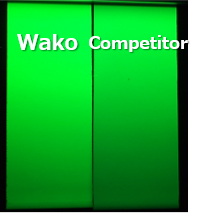
Compared to other company’s products, the fluorescence intensity is strong and it is possible to detect spots that are difficult to see.
Excellent water resistance!

- Since it can be developed using 100% water, experiments that do not use organic solvents can be performed.
High spot convergence and high resolution!
Two types of preparative TLC with different layer thickness are available!
Silicagel 70 PF254 Plate-Wako, Silicagel 70 F254 PLC Plate-Wako
Types and feature
| for Identification | Silicagel 70 TLC Plate-Wako | Fluorescent substance is not contained. Spots can be detected by spraying color TLC stains (sulfuric acid, ninhydrin, iodine, etc.). Useful for selective detection of fluorescent analytes. |
|---|---|---|
| Silicagel 70 FM TLC Plate-Wako | FM plate is added three types of fluorescent substances (red, green, and blue), which are the three primary colors of light. Broadband UV (λ=250-400 nm) irradiation causes the entire plate to white, and samples with UV absorption turn the characteristic colored spot such as, red, blue, etc. | |
| Silicagel 70 F254 TLC Plate-Wako | A green fluorescent substance is added, so the separated spots are observed as a dark spot on a green background by UV (λ=254 nm) irradiation. | |
| for Preparative Purification | Silicagel 70 PF254 Plate-Wako | Preparative TLC plate added a green fluorescent substance and is equivalent to a Silicagel 70 TLC Plate-Wako. Layer thickness is 750 μm, by reducing the amount of sticking agent to the limit, it is possible to easily collect samples. |
| Silicagel 70 F254 PLC Plate-Wako | This is a preparative TLC plate with the layer thickness of Silicagel 70 PF254 Plate-Wako increased to 1000 μm. Larger sample amounts can be easily collected. |
Example of Deployment by Silicagel 70 F254 TLC Plate-Wako
Development of Analytical Standards
-
Silica gel 70 F254 TLC Plate-Wako

-
Same rank TLC of competitor
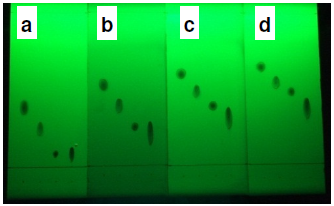
Analysys conditions
|
[Sample]
|
[Mobile phase] Chloroform: Methanol |
[Detect] UV 254 nm |
[Development distance] 10 cm |
Chromato Sheet
What is a Chromato Sheet?

The Chromato Sheet is a paper TLC in which silica gel and a fluorescent substance F254 are added to paper fibers.
Since Chromato Sheet is made of paper, it can be safely cut to any size with scissors and can write with a pencil without worrying about powder falling off.
In addition, since it is thinner than glass TLC plate and does not fall off powder from the plate, it can be attached to a notebook or filed.
Size: 20 cm x 20 cm
Features of Chromato Sheet
Chromato Sheet can be used in the same way as glass TLC plate.

*1 Do not attach the filter paper to the wall of the developing tank, because Chromato Sheet tends to absorb the solvent from the sides.
*2 TLC stains using strong acids cannot be used because it is made of paper.
*3 Fujifilm Wako has confirmed that Chromato Sheet can be heated with a heat gun (140°C) and a hot plate (200°C).
The detection behavior is equivalent to that of glass TLC plate.
The spots can be detected at the same position as glass TLC plate.
The spots sharper than filter paper chromatography.
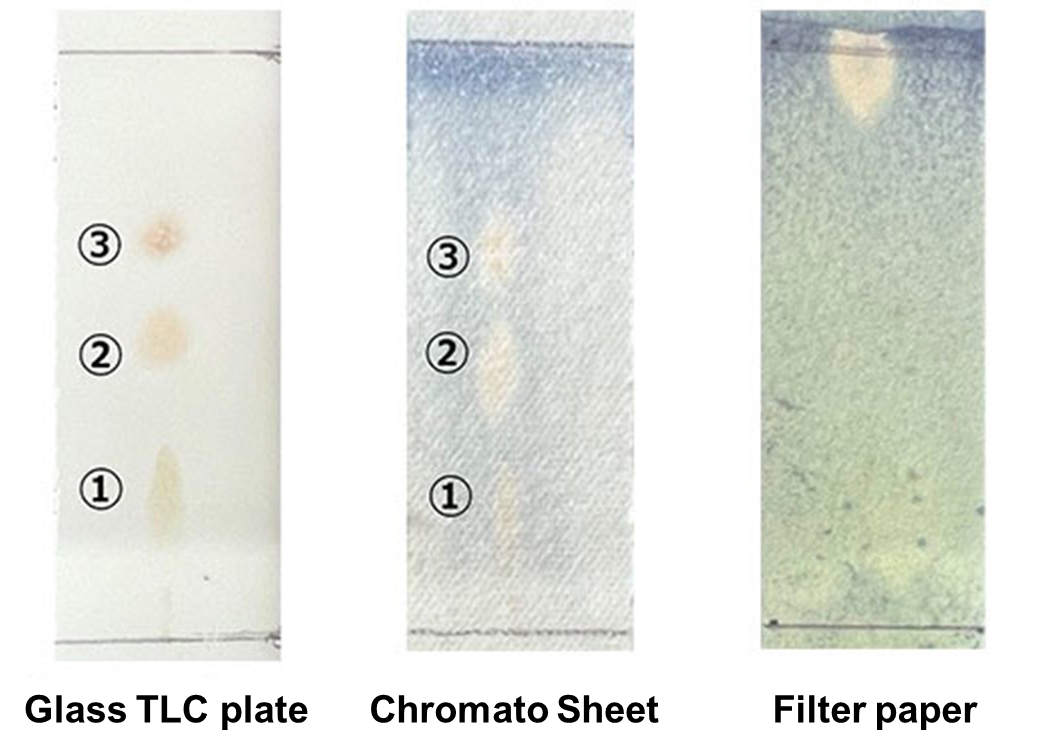
Analysis conditions
| Sample | Mixture of ① Brucine ② Oxypropyl Theophylline ③ Caffeine |
|---|---|
| Sample concentration | ① 6 mg/mL ② 10 mg/mL ③ 3 mg/mL (Solvent: chloroform 19+ ethanol (99.5) 1 (volume ratio)) |
| Spot volume | 5 μL |
| Development solvent | Chloroform 9 + methanol 1 (volume ratio) |
| Development distance | about 5 cm |
| Detection | Phosphomolybdic Acid (PMA) |
No need to separate like glass waste
Since Chromato Sheet is made of paper, it is environmentally friendly and easy to dispose after use.
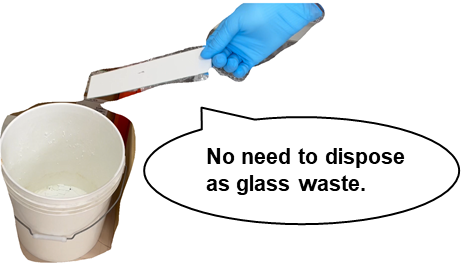
Space-saving when storing
Chromato Sheet can be stored by filing, which helps keep the laboratory bench clean.

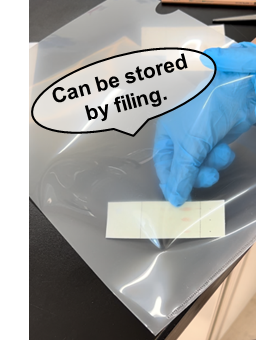
Usage that apply the characteristics of paper
For example, a Chromato Sheet can be developed in a rolled shape. Since multiple spots can be developed, it is useful for checking column fractions.
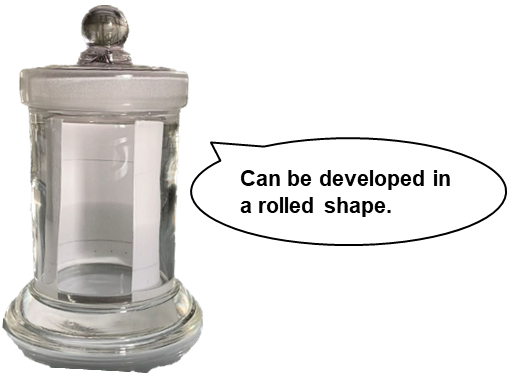

Analysis conditions
| Sample | Mixture of ① Brucine ② Oxypropyl Theophylline ③ Caffeine |
|---|---|
| Sample concentration | ① 6 mg/mL ② 10 mg/mL ③ 3 mg/mL (Solvent: chloroform 19+ ethanol (99.5) 1 (volume ratio)) |
| Spot volume | 5 μL |
| Development solvent | Chloroform 9 + methanol 1 (volume ratio) |
| Development distance | about 5 cm |
Various developing solvents and TLC stains can be used.
| Acetic Acid | 1-Butanol | Chloroform | Ethyl Acetate |
| Hexane | Methanol | Water |
| Basic Potassium Permanganate | Bromocresol Green (BCG) | Dragendorff's Reagent |
| Iodine | Ninhydrin | Phosphomolybdic Acid (PMA) |
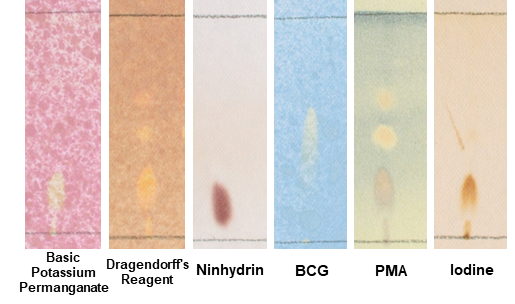
Can be cut with scissors.
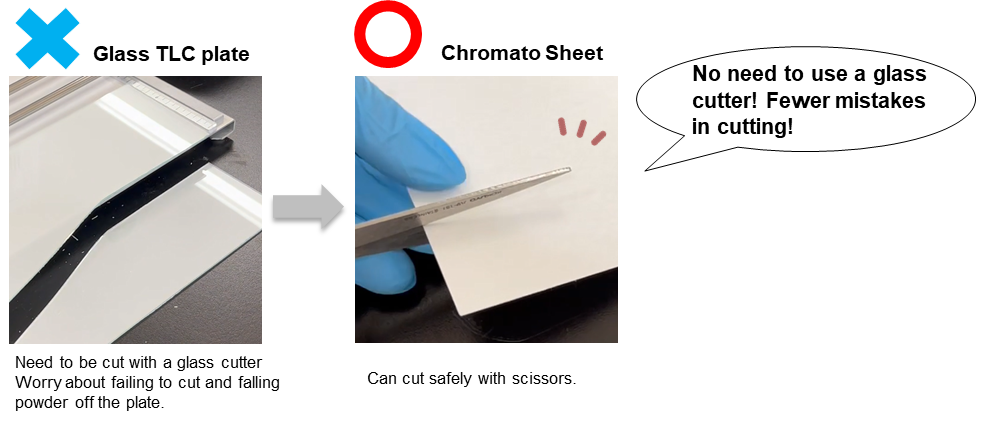
Can be written with a pencil.

Powder does not fall off.
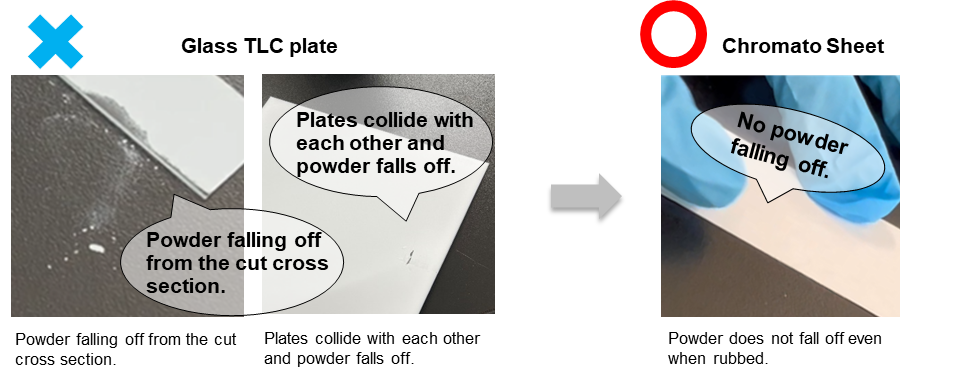
Drugs Analysis Using Chromato Sheet
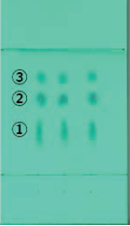
Analysis conditions
| Sample | Mixture of ① Brucine ② Oxypropyl Theophylline ③ Caffeine |
|---|---|
| Sample concentration | ① 6 mg/mL ② 10 mg/mL ③ 3 mg/mL (Solvent: chloroform 19+ ethanol (99.5) 1 (volume ratio)) |
| Spot volume | 1 μL |
| Development solvent | Chloroform 9 + methanol 1 (volume ratio) |
| Development distance | About 5 cm |
| Detection | UV 254 nm |
Product List
- Open All
- Close All
For research use or further manufacturing use only. Not for use in diagnostic procedures.
Product content may differ from the actual image due to minor specification changes etc.
If the revision of product standards and packaging standards has been made, there is a case where the actual product specifications and images are different.




